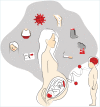Maternal acute and chronic inflammation in pregnancy is associated with common neurodevelopmental disorders: a systematic review
- PMID: 33479207
- PMCID: PMC7820474
- DOI: 10.1038/s41398-021-01198-w
Maternal acute and chronic inflammation in pregnancy is associated with common neurodevelopmental disorders: a systematic review
Abstract
Inflammation is increasingly recognized as a cause or consequence of common problems of humanity including obesity, stress, depression, pollution and disease states such as autoimmunity, asthma, and infection. Maternal immune activation (MIA), triggered by both acute and systemic chronic inflammation, is hypothesized to be one of the mechanisms implicated in the pathogenesis of neurodevelopmental disorders (NDD). Although there is substantial preclinical evidence to support the MIA hypothesis, the human evidence is disparate. We performed a systematic review on human studies examining associations between maternal inflammatory states and offspring NDDs (autism spectrum disorder- ASD, attention deficit hyperactivity disorder-ADHD, Tourette syndrome-TS). 32 meta-analyses and 26 additional individual studies were identified. Maternal states associated with ASD include obesity, gestational diabetes mellitus, pre-eclampsia, pollution, stress, depression, autoimmune diseases, and infection. Maternal states associated with ADHD include obesity, pre-eclampsia, smoking, low socioeconomic status (SES), stress, autoimmune disease, and asthma. Maternal states associated with TS include low SES, depression, and autoimmune diseases. Diverse maternal inflammatory states in pregnancy are associated with common offspring NDDs. Given the increased prevalence of NDDs, there is urgent need to explore relative and cumulative maternal risk factors and disease mechanisms. Defining preventable risk factors in high-risk pregnancies could mitigate the expression and severity of NDDs.
Conflict of interest statement
Fabienne Brilot is funded by the National Health and Medical Research Council of Australia. The other authors declare no financial/non-financial conflict of interest.
Figures





References
Publication types
MeSH terms
LinkOut - more resources
Full Text Sources
Other Literature Sources
Medical

